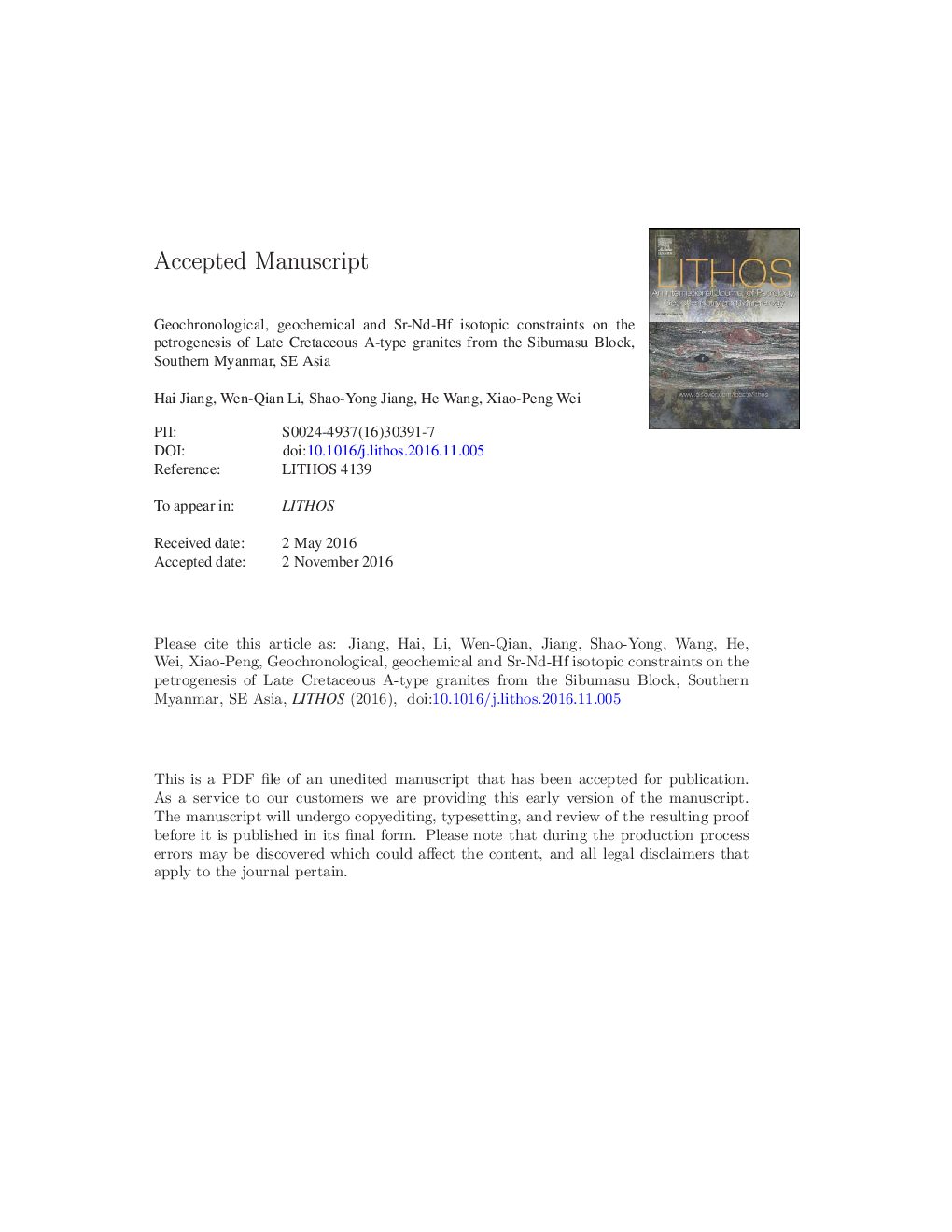| کد مقاله | کد نشریه | سال انتشار | مقاله انگلیسی | نسخه تمام متن |
|---|---|---|---|---|
| 5784335 | 1638637 | 2017 | 65 صفحه PDF | دانلود رایگان |
عنوان انگلیسی مقاله ISI
Geochronological, geochemical and Sr-Nd-Hf isotopic constraints on the petrogenesis of Late Cretaceous A-type granites from the Sibumasu Block, Southern Myanmar, SE Asia
دانلود مقاله + سفارش ترجمه
دانلود مقاله ISI انگلیسی
رایگان برای ایرانیان
کلمات کلیدی
موضوعات مرتبط
مهندسی و علوم پایه
علوم زمین و سیارات
ژئوشیمی و پترولوژی
پیش نمایش صفحه اول مقاله

چکیده انگلیسی
The Late Cretaceous to Paleogene granitoids occur widespread in the Sibumasu block within Myanmar (SE Asia), which show a close association with tin-tungsten mineralization. However, the precise timing, petrogenesis and tectonic significance of these granitoids are poorly constrained so far. In this study, we present a detailed study on geochronology, elemental and Sr-Nd-Hf isotopic geochemistry for the Hermyingyi and Taungphila granites in southern Myanmar, with the aim of determining their petrogenesis and tectonic implications. LA-ICP-MS U-Pb dating of zircon grains from the two granites yield ages of 69-70 Ma, indicating a Late Cretaceous magmatic event. These granitic rocks are weakly peraluminous and belong to the high-K calc-alkaline series. They are both characterized by high SiO2, K2O + Na2O, FeOT/(FeOT + MgO) and Ga/Al ratios and low Al2O3, CaO, MgO, P2O5 and TiO2 contents, enriched in Rb, Th, U and Y, but depleted in Ba, Sr, P, and Eu, suggesting an A-type granite affinity. Moreover, they display prominent tetrad REE patterns and non-CHARAC trace element behavior, which are common in late magmatic differentiates with strong hydrothermal interaction or deuteric alteration. The granites belong to A2-type and probably formed at a high temperature and anhydrous condition. They have zircon εHf(t) values from â 12.4 to â 10.0 and whole-rock εNd(t) values from â 11.3 to â 10.6, with Paleoproterozoic TDM2 ages (1741-1922 Ma) for both Hf and Nd isotopes. Geochemical and isotopic data suggest that these A-type granites were derived from partial melting of the Paleoproterozoic continental crust dominated by metaigneous rocks with tonalitic to granodioritic compositions, without significant input of mantle-derived magma and followed by subsequent fractional crystallization. By integrating all available data for the regional tectonic evolution in SE Asia and adjacent regions, we attribute the formation of the Late Cretaceous A-type granites to a back-arc extension in the hinterland behind the subduction zone, which is induced by the rollback of the flat Neo-Tethyan subducting slab around ca. 70 Ma.
ناشر
Database: Elsevier - ScienceDirect (ساینس دایرکت)
Journal: Lithos - Volumes 268â271, January 2017, Pages 32-47
Journal: Lithos - Volumes 268â271, January 2017, Pages 32-47
نویسندگان
Hai Jiang, Wen-Qian Li, Shao-Yong Jiang, He Wang, Xiao-Peng Wei,